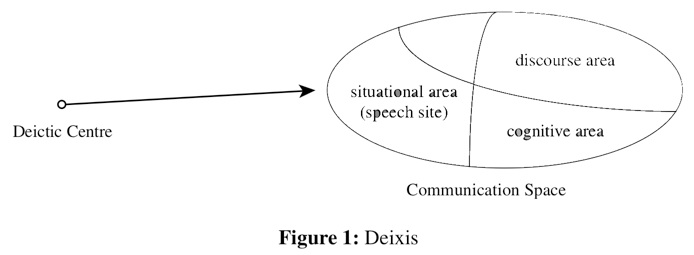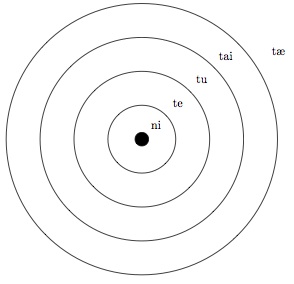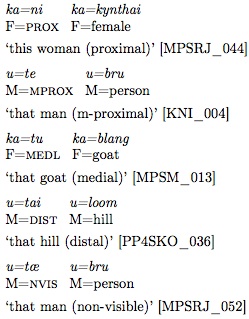At the Himalayan Languages Symposium last week I gave a talk about deixis. This grammatical feature is essentially ‘pointing’, and words or morphemes in language can point to various things, so grammarians often talk about person or distance-based deixis, social deixis, and temporal deixis.

Distance-based deixis is often encoded in words called ‘demonstratives’, social deixis in ‘honorifics’ like “sir”, “ma’am” etc.., and temporal deixis is encoded in tense markers. Deixis is actually more complex, though, as deictic morphemes can really point to any point in the communication space, as illustrated in the diagram on the right from Gerner (2009).
Since deixis is such a large topic, my 20-minute talk focused on the way distance-based deixis is encoded in Pnar and in related languages through demonstratives, specifically words that identify the location of nouns in space, relative to a deictic center. Most languages have at least a 2-way contrast (like English “this” and “that”), and rarely more than three. I began to be interested in this feature since in Pnar there is a 5-way contrast in demonstratives and some of the forms resemble similar words in neighboring Tibeto-Burman languages (a completely different language family). Just to illustrate, below on the left are the spatial deictic morphemes in Pnar (the black circle in the middle represents the ‘deictic center’, which in this case is the person who is speaking), and on the right are the words in some examples of noun phrases in Pnar. You will notice that demonstratives in Pnar are a combination of deictic markers with gender proclitics that identify the noun that the demonstratives are pointing to.


At this point there are a lot of other things I could discuss, but the post is getting a bit long. So I think I’ll pause here and my next post will be about the features of demonstratives in neighboring languages. At least now you have a better idea of what deixis is, and how languages can differ significantly in terms of what they can encode in a spatial deictic system.
References
Gerner, Matthias. 2009. Deictic features of demonstratives: a typological survey with special reference to the Miao group. The Canadian Journal of Linguistics/La revue canadienne de linguistique 54:43–90.